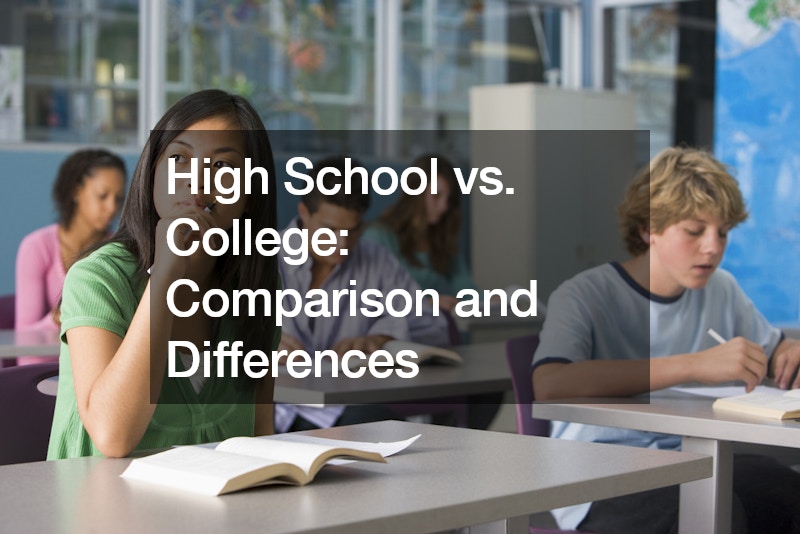In the journey of education, transitioning from high school to college marks a significant milestone. While high school serves as a stepping stone toward higher learning, college represents a new chapter of academic and personal growth. Understanding the disparities between these two educational stages is crucial for students embarking on this transformative journey.
Freedom and Independence
One of the most noticeable distinctions between high school and college is the level of freedom and independence afforded to students. In high school, students often adhere to rigid schedules and rules, with limited autonomy over their choices.
Conversely, college offers a newfound sense of freedom, where students have greater control over their schedules, courses, and extracurricular activities. This newfound independence can be liberating yet challenging, requiring students to manage their time and responsibilities effectively.
Academic Rigor
While high school curriculum provides a structured approach to learning, college courses demand a higher level of academic rigor and self-discipline. College classes are often more intensive and fast-paced, requiring students to engage critically with course material and take responsibility for their learning. Moreover, college professors may have different expectations compared to high school teachers, placing greater emphasis on independent thinking, analysis, and creativity.
Financial Responsibilities
Another significant difference lies in the financial responsibilities associated with college education. Unlike high school, where education is typically free, college tuition fees can be substantial. Additionally, students may incur expenses for textbooks, housing, meals, and other necessities. Managing finances becomes paramount, and students may need to seek financial aid or part-time employment to cover expenses. College counseling services can provide valuable assistance in navigating financial aid options and budgeting effectively.
Social Dynamics
The social dynamics in college differ significantly from those in high school. While high school often revolves around established social hierarchies and peer groups, college offers a more diverse and inclusive environment. Students have the opportunity to interact with individuals from various backgrounds and cultures, fostering personal growth and broadening perspectives. Moreover, college provides ample opportunities for involvement in clubs, organizations, and community service activities, allowing students to explore their interests and passions outside the classroom.
Academic Support
In high school, students typically receive extensive support from teachers, counselors, and administrators. However, in college, the responsibility for seeking academic support falls primarily on the students themselves. While professors and academic advisors are available to offer guidance, students must take the initiative to seek assistance when needed. College counseling services play a vital role in providing academic support, offering resources such as tutoring, study skills workshops, and career counseling to help students succeed academically.
Extracurricular Activities
Extracurricular activities play a significant role in both high school and college experiences. In high school, students often have access to a wide range of activities, including sports teams, clubs, and community service opportunities, which can enhance their social skills, leadership abilities, and overall well-being. However, participation may be more structured and supervised. In college, students enjoy greater autonomy in choosing activities and may have access to a broader array of options, such as academic clubs, research opportunities, and internships. Engaging in extracurriculars can enrich the college experience, provide networking opportunities, and complement academic learning. While the emphasis on extracurricular involvement may vary between high school and college, both settings offer valuable avenues for personal growth and development.
Transition Challenges
The transition from high school to college presents various challenges for students, including academic, social, and emotional adjustments. Academically, students may face challenges such as adapting to college-level coursework, managing increased academic rigor, and developing effective study habits. Socially, students may struggle with building new friendships, navigating campus culture, and adjusting to greater independence. Homesickness and feelings of isolation are common emotional challenges experienced by many college students, especially those living away from home for the first time. Time management skills are essential for balancing academic responsibilities, extracurricular activities, and personal commitments effectively. While the transition to college can be daunting, students can overcome these challenges by seeking support from campus resources, building strong support networks, and practicing self-care strategies. With resilience, perseverance, and a proactive approach, students can navigate the transition successfully and thrive in their college journey.
Conclusion
Navigating the transition from high school to college is a significant milestone in every student’s educational journey. Understanding the differences between these two stages of education is essential for adapting successfully to the challenges and opportunities that college presents. By recognizing the disparities in freedom, academic rigor, financial responsibilities, social dynamics, and academic support, students can better prepare themselves for the transformative experience of college life. Through proactive engagement and utilization of available resources such as college counseling services, students can thrive academically, socially, and personally in their college years.
.


